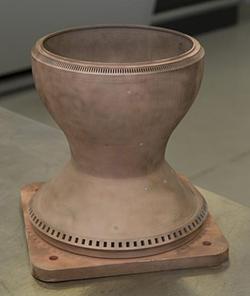NASA 3D Prints Rocket Engine Part -- This Time From Copper
May 8, 2015

NASA has been working on several different ongoing projects for 3D-printed rocket engine components in metals, as we've told you. Now it's reached another first in aerospace 3D printing: a full-scale, 3D-printed rocket engine component made of copper.
Copper is well-known for its heat-conducting abilities in uses from electronics to cookware. But this very reason makes it harder to work with: the copper powders in selective laser melting (SLM) processes like NASA's don't easily melt in the continuous way needed. As a result, very few copper rocket parts have been made with 3D-printing methods.

NASA's copper part is a rocket engine combustion chamber liner that operates at insanely high and low temperatures and pressures. Inside the chamber, propellant burns at 5,000F on the liner's paper-edge thin wall. Outside, hydrogen gas must be kept at temperatures less than 100 degrees above absolute zero to prevent the liner from melting. Between the inner and outer walls of the combustion chamber liner, more than 200 tiny cooling channels circulate the gas.
To fabricate the complex internal geometries of these chambers was a major challenge, said Chris Singer, director of the Engineering Directorate at NASA's Marshall Space Flight Center. Even so, making the part with 3D printing can potentially reduce the time and cost of making rocket engine parts like this one.
MORE FROM DESIGN NEWS: Vulcan & Atlas V Rockets Will Fly on 3D-Printed Parts
After several test parts were made to characterize the material and create a copper additive manufacturing process, NASA's team used an SLM machine to fuse together 8,255 layers of copper powder to make the chamber liner. That took nearly 11 days. The powder is GRCo-84, an alloy invented by materials scientists at NASA's Glenn Research Center.
The center is developing an extensive database of mechanical properties to help guide future 3D-printed rocket engine designs. The data will be made available in NASA's Materials and Processing Information System (MAPTIS), managed by Marshall, to boost the industrial competitiveness of US manufacturers.
MORE FROM DESIGN NEWS: NIST Report Analyzes Measurement Needs for Powder Metal 3D Printing
Ann R. Thryft is senior technical editor, materials & assembly, for Design News. She's been writing about manufacturing- and electronics-related technologies for 25 years, covering manufacturing materials & processes, alternative energy, machine vision, and all kinds of communications.
Atlantic Design & Manufacturing, the largest advanced design and manufacturing trade show serving the Northeastern US, delivers thousands of senior level design and manufacturing professionals who are looking for new ideas, innovations, and solutions. A Design News event, Atlantic Design & Manufacturing will take place in New York, June 9-11, 2015. It's your chance to meet qualified suppliers, get hands-on with the latest technologies, and expand your network. Learn more here.
About the Author(s)
You May Also Like


.jpg?width=300&auto=webp&quality=80&disable=upscale)
